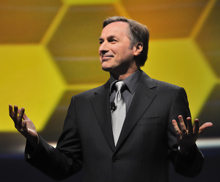Lawson Software: Positive first impressions

I'm currently attending Lawson Software's annual conference, called CUE 09, in San Diego. Since this is my first in-depth exposure to the company, I thought it appropriate to share a few thoughts and comments.
Overall, I like the company: the people are nice, they articulate product strategy clearly, and senior management obviously wants to create a positive customer experience. Lawson presenters wove the customer satisfaction theme through presentations to bloggers and analysts.
Technology. Although Lawson announced new features and significant user experience improvements in the company's products, their technology seems to lag behind some competitors. I asked fellow Enterprise Irregular, Vinnie Mirchandani, to comment on this last point:
Looking at Lawson within the context of industry trends, such as SaaS, cloud computing, next generation analytics, and mobile computing, the company seems behind the curve. Yes, they're doing things their customers want and request, but Lawson seems to have a legacy mindset, similar to the MISO companies (Microsoft, Oracle and SAP).
In fairness, it's important to recognize that bloggers sometimes push the technology edge harder than software buyers. Lawson customer Paul Parish from Catholic Health Initiatives, which runs 77 hospitals, made this point during conversation with Vinnie and me:
We are not even on the latest version, so advanced functionality is less significant than productivity gains. We don't need to be on the bleeding, cutting edge.
Keynote. The main keynote presentation, led by CEO Harry Debes, was a relatively down-to-earth affair, in contrast to the slick, highly produced presentations one sees from the larger MISO companies. I found this less flashy style to be accessible and believable.

Importantly, Harry carefully drew a distinction between real, shipping products and visionary descriptions of future goals. While less exciting than elaborately staged demos, which sometimes blur distinctions between reality and vaporware, I enjoyed this straightforward directness.
During the keynote, Catholic Health Initiative's Parish described his organization's implementation project in some detail. As an IT failures blogger, I was pleased that Lawson chose to emphasize implementation as a strategic, keynote-worthy issue. Other enterprise software companies, please take note.
Customer service attitude. During a private conversation with Lawson's Chief Customer Officer, Peter Quinn, Vinnie and I received a detailed introduction to the company's thinking about customer satisfaction. Peter's role involves listening to customer feedback and communicating that information back to internal Lawson groups. Management clearly intends to increase overall company responsiveness to customer needs, goals, and issues.
Peter's role is new, so the jury is still out regarding his ability to navigate complicated internal corporate politics to successfully achieve the mandate. Customer satisfaction is a nice buzzword, but what happens when short-term financial goals conflict with the longer-term benefits associated with increased customer responsiveness? Peter's success depends on Lawson's willingness to accept a meaningful customer satisfaction agenda even when it costs the company money.
Blogger program. This conference is Lawson's first substantive attempt to engage with bloggers. Despite some early logistical issues, the company assembled a solid schedule of meetings between bloggers and senior executives. Importantly, Lawson is giving bloggers plenty of unescorted alone time with customers. In addition to Vinnie and me, enterprise blogger, Frank Scavo, is also here.
[Disclosure: Lawson reimbursed my out-of-pocket travel expenses. Photo of Lawson CEO, Harry Debes, by Michael Krigsman.]